How to Care for a Flemish Giant Rabbit
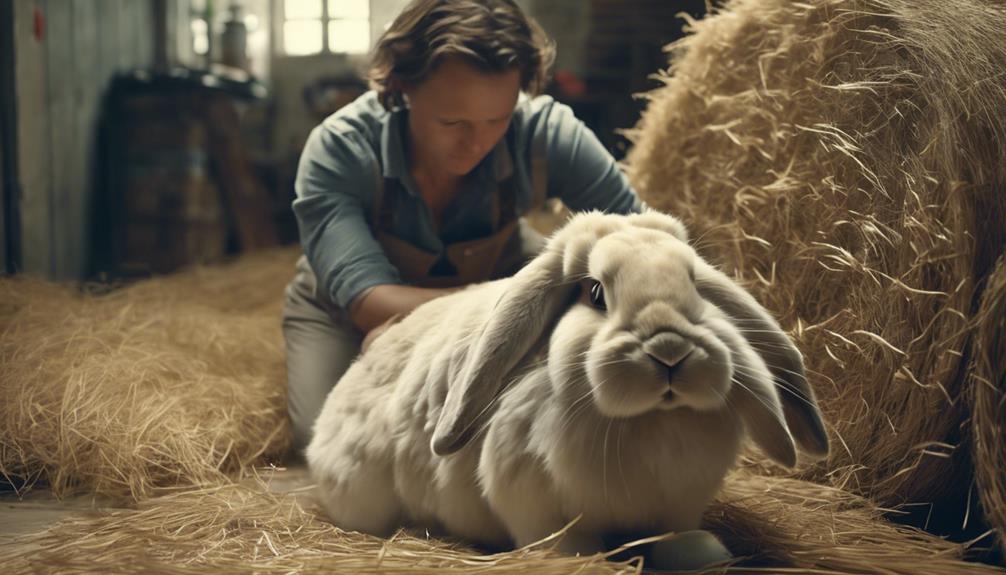
Flemish Giant rabbits are known for their large size, gentle temperament, and playful nature. To ensure the well-being and happiness of your Flemish Giant, it is important to provide them with proper care and attention.
- Housing: Flemish Giants need a spacious and well-ventilated enclosure to move around comfortably. Ensure that the enclosure is large enough to accommodate their size and provide hiding spots for them to feel secure.
- Diet: A healthy diet is essential for the overall health of your rabbit. Feed them a balanced diet consisting of hay, fresh vegetables, and a small amount of pellets. Make sure they have access to fresh water at all times.
- Exercise: Flemish Giants are active rabbits that require regular exercise to stay healthy. Provide them with opportunities to hop and run around in a safe and secure space.
- Grooming: Regular grooming is important to keep your rabbit’s fur clean and free of mats. Brush their fur gently to prevent tangles and remove loose hair.
- Veterinary Care: Schedule regular check-ups with a rabbit-savvy veterinarian to ensure your Flemish Giant is in good health. Keep an eye out for any signs of illness or discomfort and seek medical attention if needed.
By providing your Flemish Giant rabbit with proper care, attention, and love, you can ensure that they live a happy and healthy life as part of your family.
Flemish Giant Rabbit Diet
When caring for a Flemish Giant rabbit, it’s essential to pay close attention to their diet to ensure their overall health and well-being. A diet rich in hay is crucial for these rabbits, constituting the majority of their daily food intake. Hay helps maintain proper digestion and dental health. Fresh vegetables should be offered in moderation to supplement their diet with essential nutrients and provide variety. Pellets should be limited to prevent obesity, and they should be high in fiber to support digestive health. Treats should be given sparingly, focusing on natural, rabbit-safe options to prevent weight gain and other health issues.
In addition to a balanced diet, access to fresh, clean water is vital for a Flemish Giant rabbit’s well-being. Water should be provided in a clean container and changed daily to ensure freshness. By carefully managing their diet, including hay, fresh vegetables, pellets, and occasional treats, along with ensuring a constant supply of clean water, owners can help their Flemish Giants thrive and lead healthy lives.
Housing for Flemish Giants
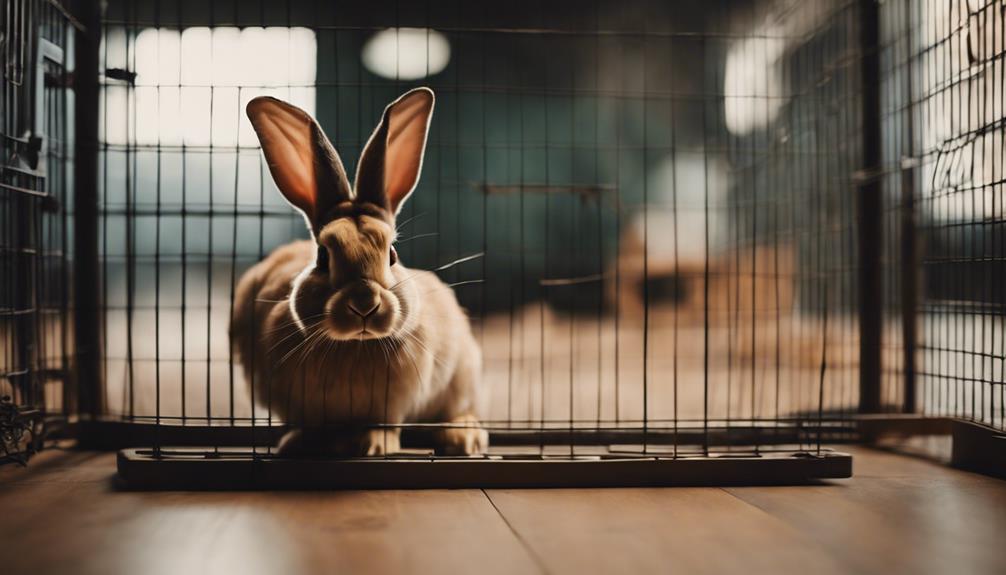
Flemish Giants require a spacious cage due to their large size. The dimensions should be at least 36′ wide, 36′ tall, and 120′ long for comfort. Providing supervised playtime outside the cage is crucial for their mental and physical well-being.
It’s important to consider doubling the cage size if housing more than one Flemish Giant to ensure they have ample space.
Cage Size Requirements
To properly accommodate the size and needs of a Flemish Giant rabbit, it’s essential to provide a spacious cage that’s at least 36 inches wide, 36 inches tall, and 120 inches long. When setting up the cage for a Flemish Giant, consider the following:
- Width: 36 inches – Allow ample space for the rabbit to move around freely.
- Height: 36 inches – Provide vertical space for the rabbit to stand on its hind legs comfortably.
- Length: 120 inches – Ensure a long enclosure to support the rabbit’s need for exercise and exploration.
- Supervised Time: Allow the rabbit supervised time outside the cage for socialization and mental stimulation.
Bedding and Litter Options
For optimal comfort and cleanliness, Flemish Giant rabbits require bedding that’s absorbent, such as hay or straw, and a litter box with rabbit-safe options for waste management.
It’s important to avoid cedar or pine shavings as bedding, as they can harm the rabbits’ respiratory systems. Opt for paper-based or pelleted litter in the litter box. Regularly changing the bedding and litter will help prevent odor buildup and maintain a hygienic environment for your Flemish Giant.
For added comfort and easy cleaning, consider using fleece liners in the cage, especially for older rabbits with sensitive feet. Keeping their living area clean and comfortable is essential for the overall well-being of your Flemish Giant rabbit.
Exercise Needs of Flemish Giants
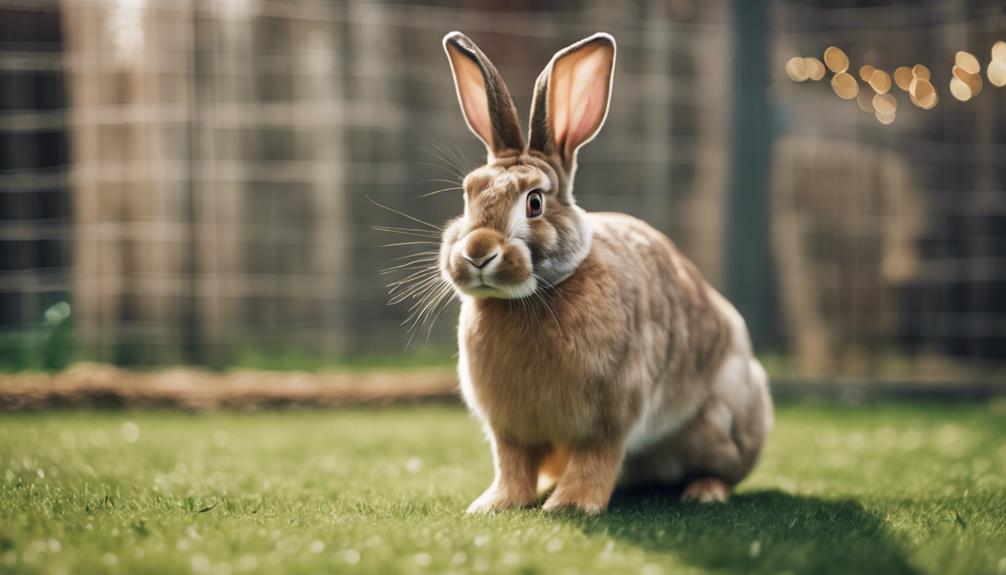
Flemish Giant rabbits require a minimum of 4 hours of exercise outside their enclosure on a daily basis to maintain their health and prevent obesity. They thrive on activities such as hopping, running, and exploring in a secure, rabbit-proofed space.
Providing a spacious playpen or designated room that’s safe for rabbits allows these giants to stretch their legs and engage in physical activities that support their overall well-being.
Exercise Frequency
Ensuring the health and vitality of Flemish Giants involves providing them with a minimum of four hours of daily exercise outside their cage. This exercise frequency is crucial for their well-being.
Here are some essential points to consider:
- Supervised Playtime: Engage them in activities in a secure, rabbit-proofed area to prevent injury and ensure their safety.
- Prevent Obesity: Regular exercise helps to maintain a healthy weight and prevent obesity-related health issues.
- Promote Digestive Health: Movement aids in promoting good digestion and prevents gastrointestinal problems.
- Overall Well-being: Exercise contributes to their mental and physical well-being, keeping them happy and active throughout the day.
Suitable Activities
To meet the exercise needs of Flemish Giant rabbits adequately, owners should engage them in a variety of suitable activities both indoors and outdoors. Supervised outdoor play in a secure area allows for natural behaviors like digging and exploring, contributing to their physical health. Interactive toys, tunnels, and obstacle courses not only provide mental stimulation during playtime but also help prevent obesity. Regular play sessions with these tools promote muscle tone, prevent boredom, and enhance the overall well-being of Flemish Giants. Owners can create a stimulating environment by incorporating different activities that cater to their rabbit’s needs, ensuring a happy and healthy pet.
| Activity | Description | Benefits |
|---|---|---|
| Outdoor Play | Supervised play in a secure area | Natural behaviors, physical health |
| Interactive Toys | Toys, tunnels, obstacle courses | Mental stimulation, obesity prevention |
| Indoor Activities | Play areas with hiding spots | Prevents boredom, overall well-being |
Grooming a Flemish Giant Rabbit
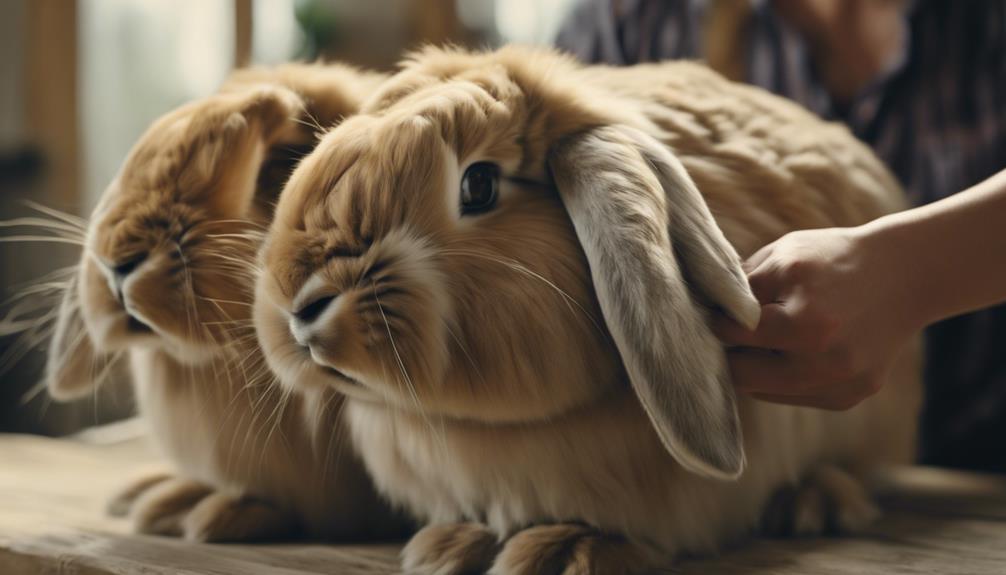
Regular grooming is essential for maintaining the health and well-being of a Flemish Giant rabbit. To properly groom a Flemish Giant, follow these steps:
- Brushing: Gently brush the rabbit’s fur regularly to prevent matting and remove any loose fur. This helps to keep the rabbit’s coat clean and healthy.
- Checking for Issues: During grooming sessions, inspect the rabbit for signs of mites, ear infections, and abscesses. Early detection of these issues is crucial for timely treatment.
- Trimming Nails: Trim the rabbit’s nails regularly to prevent overgrowth, which can lead to discomfort and potential health problems. Use proper nail clippers designed for rabbits.
- Monitoring Teeth: Keep an eye on the rabbit’s teeth for malocclusion, a common problem in Flemish Giants. Maloccluded teeth can cause eating difficulties and pain, so prompt veterinary attention is necessary.
Health Care for Flemish Giants
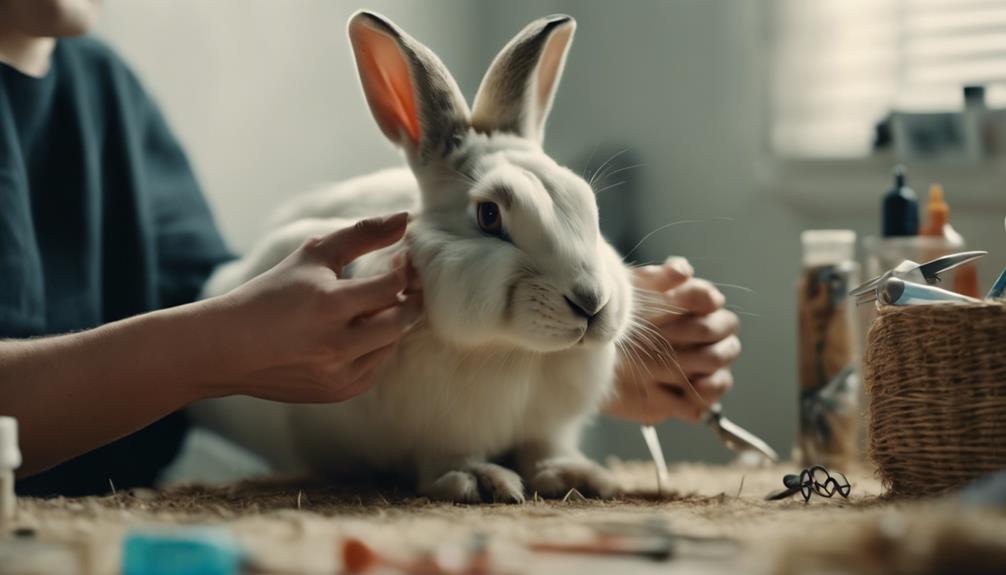
Health monitoring is crucial for maintaining the well-being of Flemish Giant rabbits, given their susceptibility to various health issues. Flemish Giants are prone to heatstroke, especially in hot weather, due to their large size and thick fur; hence, it’s important to provide adequate ventilation and cool areas for them.
GI stasis is a serious concern for these rabbits, with symptoms like lethargy and loss of appetite signaling a potentially fatal condition that requires immediate veterinary attention. Regular dental checkups are essential to prevent malocclusion, a common issue in Flemish Giants resulting from overgrown teeth.
Additionally, proper bedding and foot care are necessary to prevent sore hocks, a common problem in these rabbits due to their heavy weight. Female Flemish Giants are at risk of uterine cancer, emphasizing the importance of spaying to mitigate this serious health issue.
Owners should be vigilant in observing any changes in their rabbit’s behavior or eating habits, as early detection and intervention can significantly impact the health and longevity of Flemish Giants.
Socialization Tips for Flemish Giants
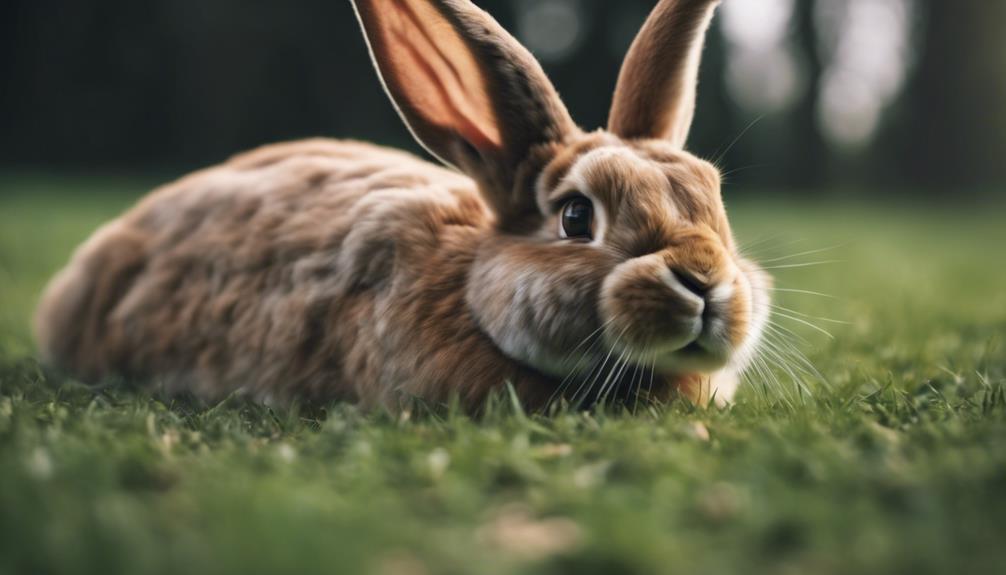
Given their social nature, Flemish Giant rabbits thrive on interaction and companionship with both humans and other animals, making socialization a key aspect of their well-being. To ensure a strong bond with your Flemish Giant, consider the following tips:
- Introduce Variety: Expose your rabbit to different environments and experiences gradually. This helps prevent stress and allows them to adapt comfortably.
- Quality Interaction: Spend quality time interacting with your Flemish Giant daily. This helps build trust and strengthens the bond between you and your rabbit.
- Provide Enrichment: Offer a variety of toys and enrichment activities to keep your Flemish Giant mentally stimulated and prevent boredom. This can include puzzle feeders, tunnels, or chew toys.
- Supervise Interactions: When introducing your Flemish Giant to children or other pets, always supervise the interactions closely. This ensures the safety and well-being of your rabbit and promotes positive social experiences.
Training a Flemish Giant Rabbit
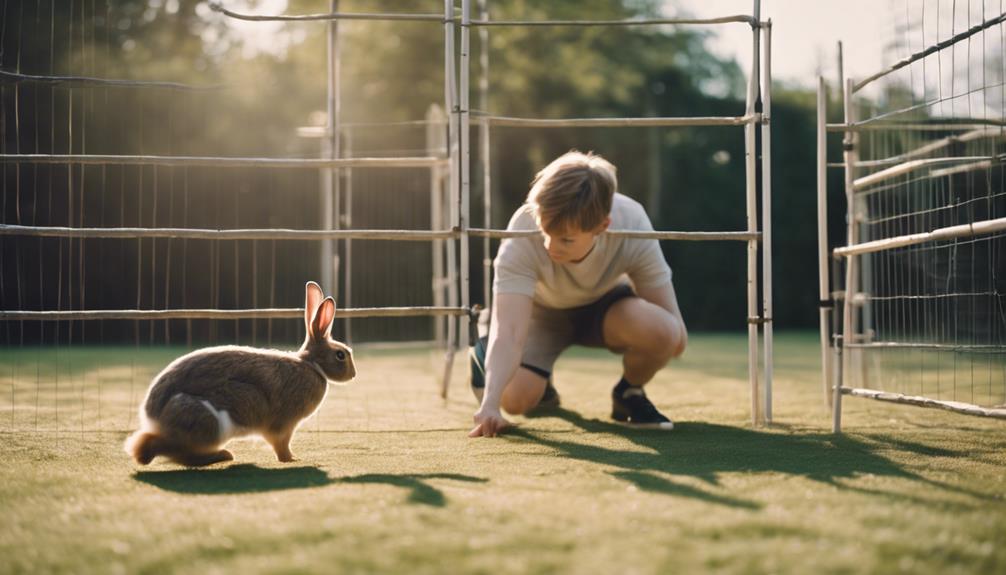
To effectively train a Flemish Giant rabbit, utilize positive reinforcement techniques to cultivate desired behaviors and foster a strong bond with the rabbit. Training a Flemish Giant rabbit can encompass various aspects such as litter box training, teaching basic commands, and socializing the rabbit with humans and other pets. Consistent training is essential, requiring patience and dedication from the owner.
Positive reinforcement, like offering favorite treats or toys, can serve as effective rewards during training sessions, encouraging the rabbit to repeat desired behaviors. When training a Flemish Giant rabbit, focus on building trust, setting clear boundaries, and establishing a positive relationship with the rabbit.
Through consistent training practices, the rabbit can learn to respond well to commands and develop a deeper bond with its owner. Remember, training should be a positive experience for both the rabbit and the owner, strengthening their connection and enhancing the rabbit’s well-being.
Frequently Asked Questions
Are Flemish Giant Rabbits High Maintenance?
High maintenance, Flemish Giant rabbits require diligent care. Regular grooming needs, ample exercise requirements, proper feeding habits, and socialization tips are essential. Health concerns like GI stasis and housing options impact their well-being. Bonding activities foster companionship.
Are Flemish Giant Rabbits Easy to Take Care Of?
Flemish Giant rabbits are relatively easy to care for due to their gentle nature and simple needs. Regular grooming, a proper diet, and spacious housing are key. Bonding through supervised playtime and socialization enhances their well-being.
Do Flemish Giants Like to Be Held?
Flemish Giants have individual preferences regarding handling. They generally prefer their feet on the ground for security. Bonding activities, trust building, and respecting personal boundaries can help them become more comfortable with brief, gentle handling sessions.
Do Flemish Giant Rabbits Like Being Picked Up?
Flemish Giant rabbits generally don’t enjoy being picked up. Bonding techniques, like respecting their boundaries, using positive reinforcement, and creating a comfortable environment, are essential. Socialization methods should focus on building trust and minimizing handling to prevent stress.









